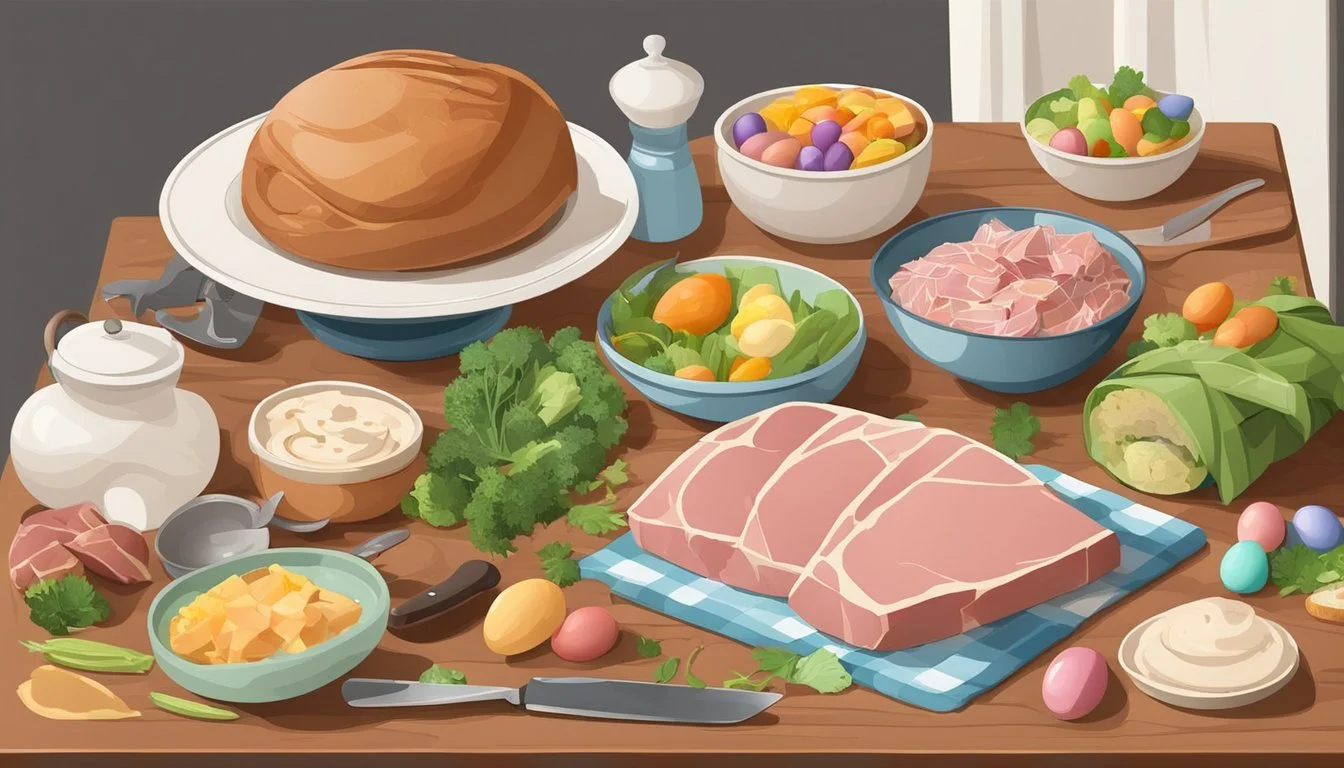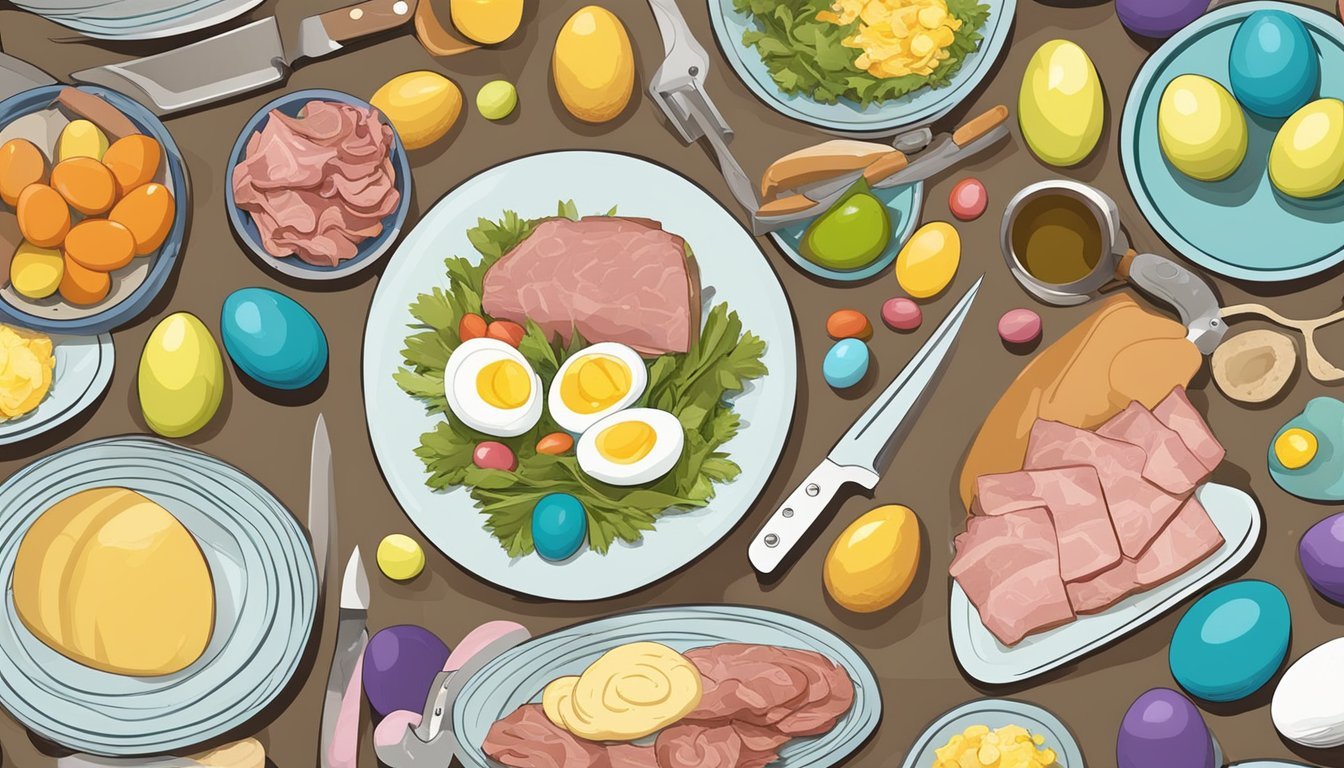Easter Leftovers
Creative Ways to Repurpose Your Feast into New Delicious Dishes
Easter celebrations often culminate in a bountiful feast, leaving many with an abundance of leftovers. The challenge of reinventing these remnants looms over the household, though it presents an opportunity for culinary creativity. Rather than resigning these dishes to a fate of waste or repetitive meals, there are numerous ways to repurpose them into exciting new dishes, breathing life into what was once a festive spread.
Turning Easter leftovers into deliciously novel creations not only reduces waste but also extends the holiday's joy through inventive cooking. Whether one has extra hard-boiled eggs, surplus ham, or an array of vegetable sides, there's potential in every leftover item. Bread (how long does bread last?) rolls, for instance, can transform into a sumptuous bread pudding or act as the foundation for delightful sliders, while the remnants of roasted meats (What wine goes well with roasted meats?) can be incorporated into hearty soups or vibrant salads.
The key to successfully repurposing a feast lies in seeing ingredients not for what they've been, but for what they could become. Leftover vegetables might find new life in a wheatberry bowl, while that uneaten ham could become a centerpiece of an omelette roll-up or flavor a comforting chowder. By looking at leftovers with a creative lens, one can assemble meals that are as satisfying and flavorful as the original Easter banquet.
Maximizing Leftover Ingredients
After the Easter festivities have wound down, the feast doesn't have to end. With a little creativity, those leftovers can be transformed into exciting new dishes. Below are several ways to give a second life to your holiday meal components.
Easter Egg Uses
Leftover hard-boiled eggs can be made into a classic egg salad, or for a twist, try incorporating them into pickles for a tangy treat. Alternatively, convert peeled eggs into creamy deviled eggs for a quick snack.
Reinventing Breads and Rolls
Leftover bread and rolls are perfect for French toast the next morning. For those dry pieces, dice them up to create homemade croutons for salads, or consider adding them to stuffing recipes to complement another meal.
Transforming Meats
Whether it's Easter ham, leftover lamb, chicken, or turkey, there are many opportunities to repurpose these proteins. Think of using ham for Hawaiian pizza toppings (What wine goes well with pizza toppings?) or sliders, and lamb or chicken can enhance a quinoa salad or be the star of a hearty sandwich.
Vegetable Makeovers
Leftover vegetables such as spinach, asparagus, and peas can be mixed with quinoa for a nutritious salad. Mashed potatoes can be reformed into potato pancakes, while roasted veggies are great in hash browns or added to a cooked rice (how long does cooked rice last?) stir-fry.
Cheese and Dairy Delights
Cheese remnants, especially Parmesan, can be utilized in a variety of dishes, from melting into sauces to being sprinkled on baked dishes. Yogurt, if available, can make a great base for creamy dressings or dips.
Remaining Sides Repurposing
Mashed potatoes and sweet potatoes (What wine goes well with sweet potatoes?) are versatile: use them as toppings for shepherd's pie or mix into waffle batter. Leftover bread can be revitalized into a savory pudding when mixed with cheese and eggs.
Dessert Innovations
Don't let Easter desserts go to waste. Chocolate eggs can be melted down for fondue or baking, and Peeps can be chopped and used as ice cream or yogurt toppings. Leftover frosting is excellent for cookie sandwiches or as a sweet dip for fruit.
Recipe Creations
With a cascade of leftovers after Easter celebrations, transforming them into sumptuous meals through the week is both economical and inventive. Here's how to turn remnants of your feast into breakfast delights, innovative lunch (What wine goes well with lunch?) ideas, dinner specialties, and even extend their shelf life with simple preservation techniques.
Breakfast Specialties
Pancakes and French Toast: Give your breakfast a twist by incorporating minced holiday ham into pancake batter for a savory version, or dredge slices of leftover bread in egg for a rich French toast. Top with a sprinkle of powdered sugar or a drizzle of syrup to complete the dish.
Breakfast Casserole: Combine diced hard-boiled eggs, shredded lamb, or ham pieces with bread cubes, cheese, and a milk-egg mixture to create a comforting and hearty breakfast casserole.
Lunch Innovations
Egg Salad Variations:
Classic Egg Salad: Chop hard-boiled eggs and mix with mayonnaise, mustard, and a pinch of paprika.
Avocado Egg Salad: Mash avocado as a healthier substitute for mayonnaise, adding hard-boiled eggs and a dash of lime.
Cobb Salad: Layer a bed of greens with sections of hard-boiled eggs, shredded chicken, and diced ham, garnishing with blue cheese and a robust vinaigrette.
Ham and Cheese Wrap: Wrap slices of holiday ham and cheese with a touch of mayo or mustard within lettuce leaves or tortillas for a quick and satisfying lunch.
Dinner Delicacies
Quiche: (What wine goes well with quiche?) An excellent vessel for leftovers, a quiche can be filled with bits of roasted lamb, diced holiday ham, and vegetables, enveloped in a creamy egg custard and baked in a flaky crust.
Lamb Bhuna: Turn leftover lamb into a spellbinding curry rich with spices, simmering until the meat is tender and infusing it with flavors that deepen overnight.
Food Preservation Techniques
Refrigeration and Freezing Tips:
Store leftover meats like lamb and ham by wrapping them tightly and keeping them in the fridge for up to three days or in the freezer for a couple of months.
For hard-boiled eggs, peel and refrigerate in a covered container; consume within one week.
Storage for Breads:
Dry out leftover buns or rolls for homemade croutons: chop into cubes, bake until crispy, and store at room temperature.
Remember that by being creative and flexible with ingredients, Easter leftovers need not be a culinary afterthought but can instead provide the foundations for delicious meals long after the holiday is over.
Health and Dietary Considerations
When dealing with Easter leftovers, it's essential to consider health and dietary needs to ensure leftovers are repurposed in ways that align with balanced nutrition and any specific dietary restrictions.
Balanced Meal Planning
When planning meals with Easter leftovers, it's important to aim for balance, incorporating a variety of food groups to create a nutritious plate. Here's a simple guide to ensure dietary balance:
Proteins: Utilize leftover ham or other meats as a protein feature, or opt for Quinoa for a high-protein, plant-based alternative.
Vegetables: Add Vegetables like roasted carrots or brussels sprouts to meals to ensure a high fiber intake.
Whole grains: If Whole grain buns or rolls are leftover, they can be the basis for a hearty sandwich or turned into breadcrumbs for a crunchy topping.
Healthy fats: Incorporate avocados or nuts for those essential fatty acids.
Dietary Restriction Adaptations
For those with specific dietary needs, Easter leftovers can be creatively adapted:
Gluten-Free: Use gluten-free bread for breadcrumbs or stuffing. Opt for Sweet Potato as a gluten-free base for dishes.
Dairy-Free: Dairy-free milk alternatives can be used in recipes like bread pudding or mashed potatoes made from leftover buns and Sweet Potatoes.
Vegetarian/Vegan: Leftover Vegetables can be transformed into a quinoa salad or vegetable hash, ensuring they are not cooked with or contaminated by meats or animal byproducts.
Leftover Management and Safety
After enjoying an Easter feast, it's essential for one to manage leftovers safely to avoid foodborne illnesses while maximizing the utilization of the feast. Proper storage, understanding shelf life, and avoiding waste through creative repurposing are crucial.
Storage Tips
When storing leftovers, individuals should cool their food to room temperature within two hours of cooking to prevent bacterial growth. Storing food in shallow containers helps it cool evenly and quickly. It is crucial for leftovers to be sealed properly—airtight containers or resealable bags are recommended for refrigeration, while vacuum-sealed bags are ideal for freezing.
Cooling: Allow to reach room temperature, then refrigerate quickly.
Freezing: Use airtight containers to prevent freezer burn.
Shelf Life Guidelines
Every leftover has a different expiration date depending on the type of food. Generally, refrigerated cooked meats should be eaten within three to four days, while most cooked dishes containing eggs are best consumed within that timeframe as well. Freezing can extend a meal's life by months, though it is advisable to label leftovers with the date before freezing to track how long they've been stored.
Refrigeration: Consume within 3-4 days.
Freezing: Can extend shelf life for 2-6 months, depending on the dish.
Avoiding Food Waste
Reheating should be done evenly and thoroughly, bringing the food to an internal temperature of 165°F to ensure safety. Proper labeling not only helps with identifying leftovers but also with managing their consumption before they expire. Creative use includes repurposing leftovers into new dishes, which can revitalize interest and reduce waste. Unavoidable waste should be managed responsibly; food that can't be eaten can often be donated to local food banks or turned into compost for gardens.
Repurposing: Turn leftovers into new meals like soups, salads, or casseroles.
Donating: Check local guidelines for donating food to shelters or food banks.
Composting: Organic waste can enrich soil in gardens.




